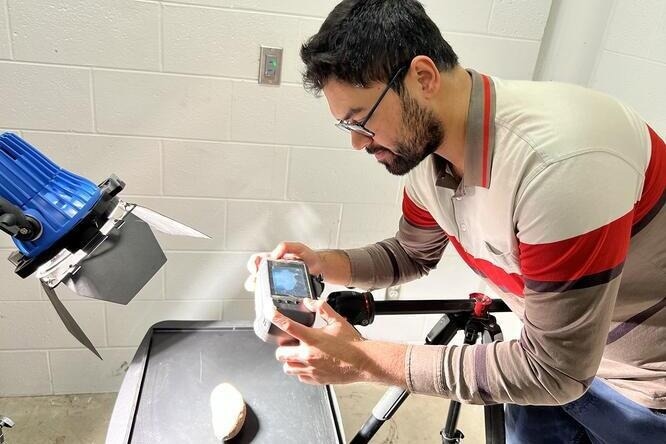Reviewed by Lexie CornerOct 1 2024
A research team from the University of Illinois Urbana-Champaign has developed a method that utilizes deep machine learning to reconstruct hyperspectral images from standard RGB photographs. The study, published in three journals—Journal of Food Engineering, Results in Engineering, and Smart Agricultural Technology—could completely transform product assessment in agriculture, simplifying the analytical process.
 Md Toukir Ahmed, doctoral student at the University of Illinois Urbana-Champaign, takes a photo of a sweet potato with a hyperspectral camera. Image Credit: University of Illinois Urbana-Champaign
Md Toukir Ahmed, doctoral student at the University of Illinois Urbana-Champaign, takes a photo of a sweet potato with a hyperspectral camera. Image Credit: University of Illinois Urbana-Champaign
Hyperspectral imaging is a useful technique for analyzing the chemical composition of food and agricultural products, but its complexity and cost limit its widespread application.
Hyperspectral imaging uses expensive equipment. If we can use RGB images captured with a regular camera or smartphone, we can use a low-cost, handheld device to predict product quality.
Md Toukir Ahmed, Doctoral Student and Study Lead Author, Department of Agricultural and Biological Engineering, University of Illinois
To test their method, researchers examined the chemical composition of sweet potatoes, focusing on two important factors: soluble solid content and dry matter. These factors influence the flavor, nutritional value, marketability, and processing suitability of the crop. Using deep learning algorithms, they converted data from standard RGB photos into hyperspectral images.
With RGB images, you can only detect visible attributes like color, shape, size, and external defects; you cannot detect any chemical parameters. In RGB images you have wavelengths from 400 to 700 nm, and three channels red, green, and blue. But with hyperspectral images, you have many channels and wavelengths from 700 to 1000 nm. With deep learning methods, we can map and reconstruct that range so we now can detect the chemical attributes from RGB images.
Mohammed Kamruzzaman, Assistant Professor and Study Corresponding Author, Department of Agricultural and Biological Engineering, University of Illinois
Hypercubes, formed by combining hundreds of narrow spectral bands at specific spatial positions, provide detailed spectral signatures through hyperspectral imaging. Kamruzzaman and Ahmed developed a model that uses deep learning algorithms to reconstruct hypercubes from standard RGB photos, enabling detailed product analysis.
Using reconstructed hyperspectral images of sweet potatoes, they calibrated the spectral model and achieved significant results: over 70 % accuracy in estimating soluble solid content and 88 % accuracy for dry matter content.
In another study, the team applied deep learning to predict chick embryo mortality from reconstructed hyperspectral images, with implications for the hatchery and egg industries. They explored various methods and recommended the most precise approach.
Our results show great promise for revolutionizing agricultural product quality assessment. By reconstructing detailed chemical information from simple RGB images, we are opening new possibilities for affordable, accessible analysis. While challenges remain in scaling this technology for industrial use, the potential to transform quality control across the agricultural sector makes this a truly exciting endeavor.
Mohammed Kamruzzaman, Assistant Professor and Study Corresponding Author, Department of Agricultural and Biological Engineering, University of Illinois
Journal References:
Md. Ahmed, T., et al. (2024) Deep learning-based hyperspectral image reconstruction for quality assessment of agro-product. Journal of Food Engineering. doi.org/10.1016/j.jfoodeng.2024.112223.
Md. Ahmed, T., et al (2024) Comparative analysis of hyperspectral Image reconstruction using deep learning for agricultural and biological applications. Results in Engineering 23. doi.org/10.1016/j.rineng.2024.102623.
Md. Ahmed, T., et al (2024) Hyperspectral image reconstruction for predicting chick embryo mortality towards advancing egg and hatchery industry. Smart Agricultural Technology. doi.org/10.1016/j.atech.2024.100533.